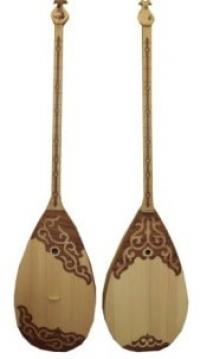Вы здесь
Dombra.

History of Kazakh musical instruments.
“The Kazakhs are a new evidence that a man was born as a poet or musician”
Shokan Valikhanov. “Hero dot us of the Kazakh steppe”
Tours & travel Kazakhstan.
Many researchers noted great variety and wealth of traditional Kazakh musical culture. Very likely one of the most spread and known Kazakh instruments all over the world is dombyra. Dombyra as archaeological data is an evidence of it has very ancient origin.
Two kinds of dombyras are known - Western and Eastern which have different shapes, what is connected with different mastery traditions and a technique of performance. There are two or three-stringed dombyras. Dombra is the most widely used Kazakh folk instrument.
Dombra can be met in each yurta; it was referred to as one the most necessary and obligatory things in the life of Kazakhs. The history of this instrument’s origin goes into the depth of centuries. There are two types of dombra – western and eastern. Different shapes of dombra were caused by the features of two performance traditions. In order to perform fast, masterly tokpe-kuis it was necessary that the left hand could easily move and slide along the neck.
That is why the neck of western dombra was thin and long. This technique could not be used when playing the eastern could not be used when playing eastern dombra with wide short neck. Sizes of instruments and shapes of the bases had an influence on the force of the sound: bigger size means louder dombra.
The sound also depended on the technique of the right hand: in tokpe-kuis the sound was extracted on both strings with strong hand movements, and in shertpe soft plucking of strings with certain fingers was used. Thus, there is the close link between the shape of domra and kuis performed. Dombra could be not only two-string but also three-string. In the past three-string dombras could be met in different regions of Kazakhstan, at present they remain only in Semipalatinsk oblast.
A two-stringed dombyra is more spread than a three-stringed dombyra which at present has remained only in the Semipalatinsk oblast. The known composer and musicologist Ahmet Zhubanov in 1933 has created dombyra ensemble at the Alma-Aty is musical-drama technical school.
Since 1938 for the first time in histories of the Kazakh music, an orchestra began to execute products under notes, into its structure have been entered reconstructed kobyz, dombra. In 1944 to an orchestra the name of national singer Kurmangazy has been appropriated.
The dombra can be rightly called the queen of Kazakh instruments since the XIX-th century. Due to its wide distribution, it now comes in many local varieties that differ in shape, fingerboard length and frets.
The Western Kazakhstan dombra has a 2-octave range conforming to the elaborate nature of the region's kyui. Playing techniques reflect the dynamic style of Western Kazakhstan kyui.
The Eastern Kazakhstan dombra has a shorter fingerboard with a diapason of 1.5 octaves, which reflects the song style of local kyui and, of course, the matching techniques of playing. We also find a three-stringed dombra in Eastern Kazakhstan.
The technique of playing and sound formation of the dombra is extremely manifold giving the musicians unlimited styles in any musical piece. Dombra kyui are the acme of Kazakh music evolution.
No one dared for a long time until an old dombrist (a person who plays the dombra) attempted. The sorrowful tune of the kyui was able to send this tragic message across to the khan. He ordered that the molten lead be poured into the dombra. That was how the opening in the upper sounding board of this musical instrument came about.'
Hundreds of kyui have been created, thanks to the efforts of many generations of dombrists, including geniuses, whose music has outlasted them by centuries. The kyui is the most ample reflection of the Kazakh spirit.
After his cup of tea he hurriedly continued on his way. When the daughter of the old woman, a well-known dombrist in the lands, came home she told her about the guest. Having just touched her dombra the girl cried out. "That dzhigit is a thief!' He was chased, apprehended, and the herd returned to the owners.
The ancient magical property of talking objects known to many peoples of the world is reflected in this legend. Traditional professional singers, zhyrau (epic songers), akyn (musical-poetic contest master), sal and sere (lyric song-composer) can all not do without this most extensively played instrument - the dombra.
Dombra is the most widely used Kazakh folk instrument. Dombra can be met in each yurta; it was referred to as one the most necessary and obligatory things in the life of Kazakhs. The history of this instrument’s origin goes into the depth of centuries.
There are two types of dombra – western and eastern. Different shapes of dombra were caused by the features of two performance traditions. In order to perform fast, masterly tokpe-kuis it was necessary that the left hand could easily move and slide along the neck. That is why the neck of western dombra was thin and long. This technique could not be used when playing the eastern could not be used when playing eastern dombra with wide short neck.
Sizes of instruments and shapes of the bases had an influence on the force of the sound: bigger size means louder dombra. The sound also depended on the technique of the right hand: in tokpe-kuis the sound was extracted on both strings with strong hand movements, and in shertpe soft plucking of strings with certain fingers was used.
Thus, there is the close link between the shape of domra and kuis performed. Dombra could be not only two-string but also three-string. In the past three-string dombras could be met in different regions of Kazakhstan, at present they remain only in Semipalatinsk region.






Authority:
http://www.bukhara-carpets.com
Photo by
Alexander Petrov.







